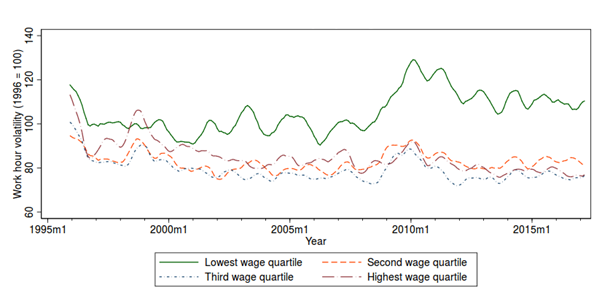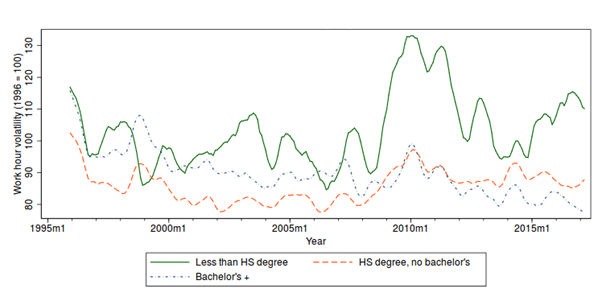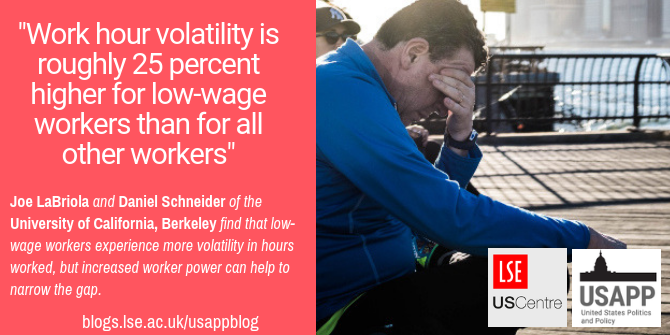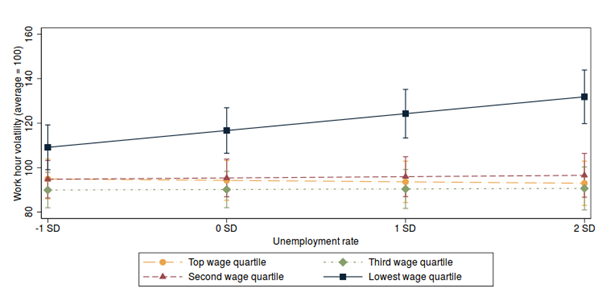
 With the rise of the “gig economy”, many workers now face uncertain schedules with large differences in their hours from week to week. In new research based on survey data, Joe LaBriola and Daniel Schneider find that the lowest waged workers experience 25 percent more volatility in the hours that they work compared to those on higher wages. They also determine that this greater volatility for low wage workers is closely linked to state unemployment rates and lower levels of union representation.
With the rise of the “gig economy”, many workers now face uncertain schedules with large differences in their hours from week to week. In new research based on survey data, Joe LaBriola and Daniel Schneider find that the lowest waged workers experience 25 percent more volatility in the hours that they work compared to those on higher wages. They also determine that this greater volatility for low wage workers is closely linked to state unemployment rates and lower levels of union representation.
The fluctuations that workers can experience in how many hours they work from week-to-week – also known as volatility – has become the focus of recent public and scholarly attention, and for good reason. Workers who experience more ups and downs in terms of the hours they work suffer from worse health-related outcomes, including increased stress and fatigue, poor sleep quality, and greater difficulties in accessing medical care. Further, work hour volatility leads to increased conflict between work and non-work obligations, as inconsistent hours can cause difficulty in accessing consistent childcare, continuing further education, and maintaining family relationships. Finally, for workers paid by the hour, work hour volatility translates to unpredictable earnings, which can prevent workers from budgeting for the future.
In new research, we document that the experience of week-to-week work hour volatility in the United States is unequal, with significant class gaps in exposure to this volatility. Using a novel method of calculating work hour volatility from data from the Current Population Survey, we find that workers in the bottom quarter of the wage distribution experience substantially higher work hour volatility than do other workers. After accounting for several demographic characteristics and for the industry and occupation of employment, we find that work hour volatility is roughly 25 percent higher for low-wage workers than for all other workers.
Figure 1 displays trends in work hour volatility by wage quartile from 1995 to 2016. Notably, while low-wage workers have had the greatest work hour volatility across most of this period, the gap in work hour volatility between low-wage workers and all other workers widened during the Great Recession, and has remained wide ever since.
Figure 1 – Work hour volatility by wage quartile

We also find gaps by education in work hour volatility over this time period. As seen in Figure 2, the story here is similar—workers without a high school degree experience the greatest levels of work hour volatility, and the gap in work hour volatility between these workers and all other workers grew during the Great Recession. However, once we account for demographic characteristics and for workers’ industry and occupation, we find that workers with a bachelor’s degree also experience relatively high levels of work hour volatility.
Figure 2 – Work hour volatility by education

What underlies this stratification in work hour volatility? We find that the experience of volatility is more unequal when workers lack power. One form of worker power—marketplace bargaining power—stems from workers operating in a tight labor market. We hypothesize that, when marketplace bargaining power is low due to high unemployment rates, the excess labor supply allows employers to adopt precarious scheduling practices that transfer economic risks to their most marginal employees. This would lead to an increase in socioeconomic gaps in work hour volatility. Another type of power—associational power—stems from workers’ collective organization through union coverage. Because unions can bargain for more stable work schedules for all workers, we hypothesize that socioeconomic gaps in work hour volatility may be smaller among workers covered by unions than among other workers.

Photo by Bruno Aguirre on Unsplash
We used state-level variation in unemployment rates to test whether socioeconomic gaps in work hour volatility are wider when workers have less bargaining power. We find robust evidence that this is the case. The widening gaps appear to be driven by disproportionate increases in work hour volatility for low-wage and less-educated workers when unemployment rates are higher.
Figure 3 shows how work hour volatility varies for workers of different socioeconomic classes by state-level unemployment rates, after controlling for other factors. At all levels of unemployment, low-wage workers experience higher work hour volatility; however, the gap clearly widens at higher unemployment rates. The work hour volatility of workers without a high school degree is also most strongly affected by rising unemployment, though at lower unemployment rates, workers with a bachelor’s degree face more work hour volatility.
Figure 3 – Predicted work hour volatility by wage quartile

We next test whether associational power reduces socioeconomic gaps in work hour volatility by comparing these gaps among workers who are and are not covered by unions. Here too, we find that for low-wage (but not less-educated) workers, work hour volatility is significantly lower among workers covered by unions than among those who are not. We estimate that union coverage lowers work hour volatility for low-wage workers by roughly 10 percent.
Our results suggest that boosting worker power may be effective in reducing socioeconomic gaps in work hour volatility. Policies geared towards ensuring full employment are likely to assist in reducing work hour volatility for low-wage and less-educated workers, though we acknowledge that variation in unemployment rates is likely to be a natural part of the business cycle. But, our results also suggest a more durable way to reduce wage-based gaps in work hour volatility—making it easier for workers to form and join unions. Union membership and coverage has declined precipitously in the last decades in the United States, and reversing this decline could reduce the degree to which low-wage workers suffer from the consequences of work hour volatility.
Finally, another effective solution may be to curtail the use of employer-driven “just-in-time” scheduling practices that are common in low-wage industries. These practices include, on the one hand, asking employees to work on call, or start earlier or stay later than initially scheduled, and, on the other hand, cancelling employees’ scheduled work shifts in the hours before their shifts start or even after they have arrived at work, in order to save on payroll costs when demand is low. In the past few years, several city and state governments have passed regulations that aim to increase schedule predictability by requiring employers to set employees’ schedules at least two weeks in advance and prevent employers from cancelling workers’ shifts at the last minute. Because these “just-in-time” scheduling practices appear to disproportionately affect low-wage workers, regulations that increase scheduling predictability are likely to also reduce wage-based gaps in work hour volatility.
- This article is based on the paper “Worker Power and Class Polarization in Intra-Year Work Hour Volatility”, in Social Forces
Please read our comments policy before commenting.
Note: This article gives the views of the author, and not the position of USAPP – American Politics and Policy, nor the London School of Economics.
Shortened URL for this post: http://bit.ly/2Kdy5Mv
_________________________________
About the authors
 Joe LaBriola – University of California, Berkeley
Joe LaBriola – University of California, Berkeley
Joe LaBriola is a Ph.D. candidate in Sociology at the University of California, Berkeley. His research broadly explores the causes and consequences of inequalities at work and home in the United States. He also studies the origins of socioeconomic gaps in parental investments in children, the role of worker power in reducing inequality in exposure to precarious work, and trajectories of work and future criminal justice contact among those who have been to prison.
 Daniel Schneider – University of California, Berkeley
Daniel Schneider – University of California, Berkeley
Daniel Schneider is an Assistant Professor in Sociology at the University of California, Berkeley. Professor Schneider’s research interests are focused on social demography, inequality, and precarious employment. His current research focuses on the contours, causes, and consequences of precarious and unpredictable work and on family structure, parenting, and inequality.






